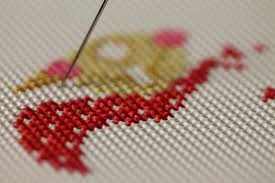Tips for Finding and Selecting Stitching Designs
Cross stitching is a popular hobby where much time is spent looking for patterns. Here are some tips for finding and selecting charts.
Along with stitching, selecting cross stitch patterns is a major part of cross stitching. When you first start stitching, it can be confusing if you don’t know how to choose a pattern that best suits your skills and interests.
Types of Cross Stitch Patterns
There are two basic kinds of cross stitch patterns or charts.
- Stamped patterns – Stamped cross stitch patterns are ideal for beginning stitchers as there is no counting. Stitchers simply stitch over x/s, pre-stamped on fabric. Along with a stamped fabric, thread and instructions are included within a kit. Besides being easy to do, stamped cross stitch patterns use fewer colors than counted cross-stitch, as much of the design, such as background is already painted onto the fabric. Another advantage is you don’t need to a chart to know where to place stitches. Because everything is laid out and all you need to do is stitch over the x’s, mistakes are fewer, if at all. On the downside, it’s not as clear to determine which colors match because different shades can look almost identical. What’s more, it can be boring if you like more of a challenge.
- Counted cross stitch patterns – Just as its name, counted cross stitch patterns are made by counting. Also easy, but somewhat more difficult than stamped cross stitching, counted cross stitch patterns are done on blank fabric. Using a chart (pattern) you count squares on an evenweave fabric, such as Aida or linen, to place stitches. Patterns can be simple, on one page or divided into several pages. Most stitchers prefer counted cross stitching because of the uniform look of the finished project. However, to work a counted cross stitch correctly, it’s imperative to miscount, as a mistake can throw off the entire project and then you’ll have to rip out and re-stitch.
Kits vs. Designs
Cross stitch kits come with complete cross-stitch materials such as chart, thread, fabric, and needle, as well as instructions. A disadvantage is that you’re stuck with the fabric in the kit. Also, sometimes there isn’t enough thread to allow for ripping because of mistakes. So, if you run out of thread, you’ll have to replace it.On the other hand, designs give you the liberty to select your fabric and floss. However, sometimes it’s hard to find all the floss you need.
Where to Find Patterns
Craft and needlework stores – Craft stores such as Joanne Fabrics, Michaels, AC Moore, and Hobby Lobby carry both kits and charts, as well as needed cross stitch supplies, including floss, needles and stitching aides. Some stores also have cross stitch books filled with designs and samplers.
Library books – Most libraries have cross stitch books with designs that you can easily reproduce on a copier machine.
Online cross stitch sites– Using your favorite search engine, search for patterns. An excellent source is one such as crossstitch.com where you can join and print out models, ranging from simple to large designs.
Photo-to-chart software – By taking any photo you can convert a picture into a cross stitch design, using cross stitch photo-to-chart software such as Pattern Maker.
Finally, the internet provides numerous cross stitch message boards. One of the most significant advantages of engaging in cross stitch message boards is getting to know other stitchers. It’s here where stitchers can trade patterns, as well as find sources for patterns. What’s more, they gain helpful tips for stitching, as well as make cyber stitching friends worldwide.

